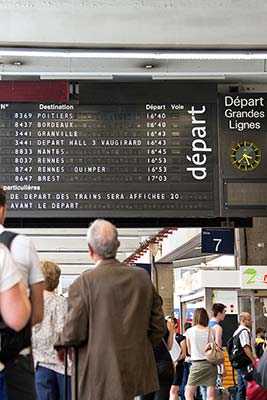
Map: Charles de Gaulle Airport
This chapter covers Paris’ two main airports, one smaller airport, seven train stations, long-distance buses, parking tips for drivers, and how to reach the city from the cruise port at Le Havre.
Whether you’re aiming to catch a train or plane, budget plenty of time to reach your departure point. Paris is a big, crowded city, and getting across town or from terminal to terminal on time is a goal you’ll share with millions of others. Factor in traffic delays and walking time through huge stations and vast terminals. At the airport, expect healthy lines at check-in, baggage check, and security points. Always keep your luggage safely near you. Thieves prey on jet-lagged and confused tourists using public transportation.
Here’s a rundown of Paris’ major airports and the best ways to get into the city from each.
Paris’ main airport (code: CDG, www.parisaeroport.fr/en/charles-de-gaulle-airport) has three terminals: T-1, T-2, and T-3. Major airlines from the US use T-1 or T-2. Connect the three terminals and several hotels with the free CDGVAL shuttle train (departs every 5 minutes, 24/7). Allow a full hour, gate-to-gate, to travel between terminals. All three terminals have access to ground transportation.
When leaving Paris, make sure you know which terminal you are departing from (if it’s T-2, you’ll also need to know which hall you’re leaving from—they’re labeled A through F). Plan to arrive at the airport three hours early for an overseas flight and two hours early for flights within Europe (particularly on budget airlines, which can have long check-in lines).
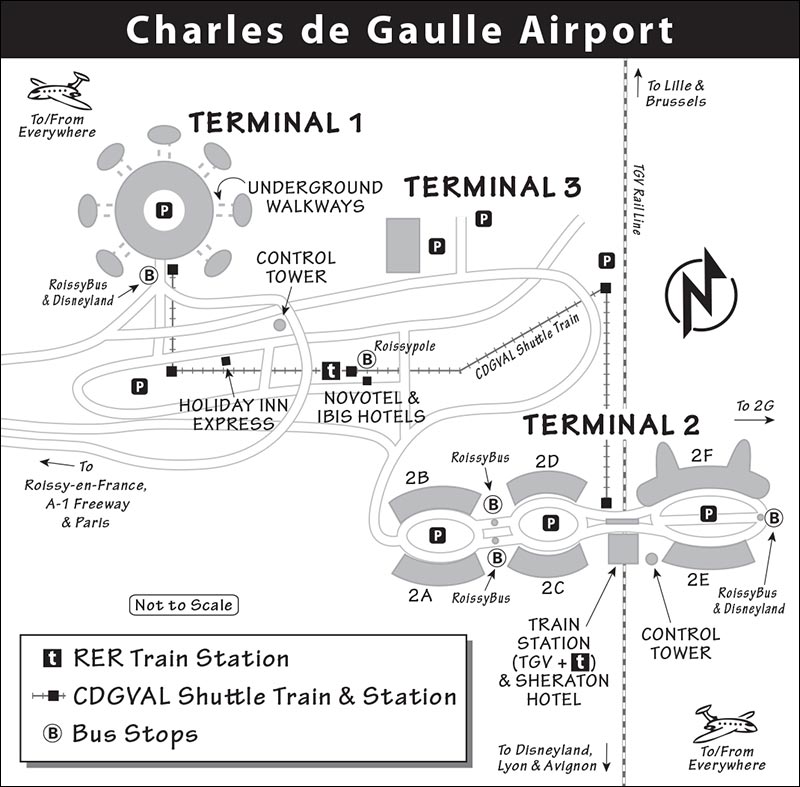
Services: Terminals 1 and 2 have Paris Tourisme information desks, where you can get city maps, buy a Paris Museum Pass, and get tickets for the RoissyBus or RER/Train-B to Paris—a terrific time- and hassle-saver. While rail ticket offices at the two airport train stations sell Navigo passes that cover the trip from the airport into Paris (for details, see here), the lines to buy them are long. Keep it simple, and get an RER ticket at the Tourisme desk (or from a machine) and deal with Navigo purchases later in Paris. You’ll also find ATMs (distributeurs) and currency-exchange desks (even in baggage claim areas), free Wi-Fi, shops, cafés, and bars. If you’re returning home and want a VAT refund, look for tax-refund centers in the check-in area.
This small, circular terminal is easy to navigate. If arriving here by bus or taxi, walk around the terminal clockwise after passing customs to find RoissyBus, Disneyland shuttles, car-rental counters, and taxis (all well signed). The Paris Tourisme desk is to the left after passing customs. The CDGVAL shuttle train is on the first floor up, check-in for departing flights and most food services are on the third floor, and arrivals are on the fifth floor.
This long, horseshoe-shaped terminal is divided into six halls, A through F. Prepare for long walks and short train rides to baggage claim and exits. It’s a busy place, so take a deep breath and follow the signage carefully.
Shuttle buses (navettes) circulate between T-2 halls A, C, and F on the arrivals level. To find bus stops for RoissyBus and the Disneyland shuttle—marked on the map on the previous page—follow bus signs and bus icons from exit (sortie) 8.
T-2 has a train station with RER trains into Paris (described later) and longer-distance trains to other areas of France, including high-speed TGV (InOui) trains. It’s located between T-2 C/D and T-2 E/F, below the Sheraton Hotel. It’s here where you’ll also find the poorly signed CDGVAL shuttle trains (just ask).
Car-rental offices, post offices, pharmacies, and ATMs are all well signed. T-2 E/F has duty-free shopping arcades, and other T-2 halls have smaller duty-free shops. You can stash your bags at Bagages du Monde, above the train station in T-2 (daily 6:00-21:30, www.bagagesdumonde.com).
The smallest of the three terminals, T-3 serves mostly smaller, low-cost, and charter airlines. It has limited shops and food services, and no tourist office or car rental. You will find direct RER service to Paris and a stop for the CDGVAL shuttle train. The handy RER-B station and RoissyBus bus stop are a five-minute walk away at Roissypole. BlaBlaBus and FlixBus depart from here, as do shuttles to airport-area hotels.
Buses, RER trains, airport vans, and taxis link the airport’s terminals with central Paris. If you’re traveling with two or more companions, carrying lots of baggage, or just plain tired, taxis (or Uber) are well worth the cost, but keep in mind that they can be slow during weekday rush-hour traffic. Total travel time to your hotel should be around 1.5 hours by bus and Métro, one hour by train and Métro, and 50 minutes by taxi. At the airport, buses and taxis require shorter walks than the RER train. Transfers to Métro lines often involve stairs and long corridors. For more information, check the “To & From” tab at ParisAeroport.fr/en/charles-de-gaulle-airport; for info on paying for the Métro, see here.
The RoissyBus drops you off at the Opéra Métro stop in central Paris (€16, runs 6:00-23:00, 3-4/hour, 50 minutes; buy ticket at airport Paris Tourisme desk, ticket machine, or on bus; www.ratp.fr [URL inactive]). The RoissyBus arrives on Rue Scribe; to get to the nearest Métro entrance, exit the bus to the left and walk toward the Fragonard store (across the street). There’s a quiet Métro entrance just across from Fragonard, toward the Opéra. For a taxi, continue walking to the front of the lavish Opéra. A taxi to any of my recommended hotels costs about €16 from here.
Paris’ commuter RER/Train-B is the fastest public transit option for getting between the airport and the city center (€11.45, runs 5:00-24:00, 4/hour, about 35 minutes; you’ll see “RER” or “Train” on maps and signage). There are two RER/Train-B train stations at CDG airport: a busy one at Terminal 2 and a quiet one near Terminal 3 (called Roissypole). The two stations are connected to all terminals by frequent CDGVAL shuttle trains.
RER/Train-B runs directly to several central RER/Métro stations (including Gare du Nord, Châtelet-Les Halles, St. Michel, and Luxembourg); from there, you can hop on the Métro to your destination. Although handy and cheap, RER/Train-B can require walking with your luggage through big, crowded stations—especially at Châtelet-Les Halles, where a transfer to the Métro can take 10 to 15 minutes and may include stairs.
To reach RER/Train-B from any airport terminal, follow Train/RER signs. (If you land at T-1, take the CDGVAL shuttle to T-3/Roissypole.)
To return to the airport on RER/Train-B from central Paris, allow plenty of time to get to your departure gate (plan for a 15-minute Métro or bus ride to the closest RER/Train-B station, a 15-minute wait for your train, a 35-minute train ride, plus walking time through the stations and airport). Navigo Découverte passes and Navigo Jour passes (with the five-zone add-on) are valid on RER/Train-B to the airport (standard two-zone Navigo Easy cards are not). When you catch your train, make sure the sign over the platform shows Aéroport Roissy-Charles de Gaulle as a stop (not every RER/Train-B serves the airport). If you’re not clear, ask another rider, “Air-o-por sharl duh gohl?”
These transportation options can be slow on weekday mornings due to rush-hour traffic.
Taxi or Uber: Taxis charge a flat rate into Paris (€62 to the Left Bank, €55 to the Right Bank). Taxis can comfortably carry three people with bags, and are legally required to accept a fourth passenger (though they may not like it; beyond that, there’s an extra passenger supplement). Larger parties can wait for a larger vehicle. Don’t take an unauthorized taxi from cabbies greeting you on arrival. Official taxi stands are well signed.
Have your hotel arrange taxi trips from Paris to the airport. Specify that you want a real taxi (un taxi normal), not a limo service that costs €20 more (and gives your hotel a kickback). For weekday-morning departures (7:00-10:00), reserve at least a day ahead (€7 reservation fee payable by credit card).
Uber offers Paris airport pickup and drop-off for the same rates as taxis, but since they can’t use the bus-only lanes (normal taxis can), expect some added time. Charles de Gaulle does not have a designated ride-sharing pickup point, making Uber a more complicated option. You’ll have to work out a meeting point with your driver.
Private Car Service: Inter Service Prestige is a reliable service with good rates (+33 7 62 23 23 31, www.isprestige.com).
Rental Car: Car-rental desks are well signed from the arrival halls. Be prepared for a maze of ramps as you drive away from the lot—get directions from the rental clerks when you do the paperwork. For information on driving and parking in Paris, see the end of this chapter.
When returning your car, allow ample time to reach the drop-off lots (at T-1 and T-2), especially if flying out of T-2. Check your rental company’s exact drop-off location—there are several, and imperfect signage can make return lots confusing to find.
The Magical Shuttle bus to Disneyland leaves from T-2 E/F, door 8, or T-1, door 34 (€24, €10 for children under 12, daily 7:00-18:00, later in summer, 45 minutes, see timetable at www.magicalshuttle.co.uk). TGV trains run to Disneyland from the airport in 10 minutes, but they leave only hourly and require a shuttle bus ride at the Disneyland end.
This easy-to-navigate airport (code: ORY, www.parisaeroport.fr/en/orly-airport) feels small, but it has all the services you’d expect at a major airport: ATMs and currency exchange, car-rental desks, cafés, shops, post offices, and more. Orly is good for rental-car pickup and drop-off, as it’s easier to navigate than Charles de Gaulle Airport.
Orly has four terminals (1-4). At all terminals, arrivals are on the ground floor (level 0) and departures are on level 1. You can connect the terminals with the free Orlyval shuttle train, which is free within the airport (well signed).
Services: Paris Tourisme desks are in the arrivals area (a good spot to buy the Paris Museum Pass and tickets for public transit into Paris).
Trams, buses, the Métro, RER trains, and taxis connect Paris with Orly. Bus stops and taxis are centrally located at arrivals levels and are well signed.
By Métro: Sometime during 2024, Métro line 14 will connect Orly Airport with Paris, serving all stops on line 14, including Gare de Lyon, Châtelet, and Gare St-Lazare. This will simplify travel from the airport to central Paris.
By Tram: For the cheapest (but slow) access to central Paris (best for the Marais area), take tram line 7 from outside Terminal 4 (direction: Villejuif-Louis Aragon) to the Villejuif station to catch Métro line 7 (you’ll need one fare for the tram and one for the Métro—buy a Navigo Easy card at the Paris Tourisme desk in the terminal, 4/hour, 45 minutes to Villejuif Métro station, then 15-minute Métro ride to the Marais).
By RER Train: Either the Orlybus or the Orlyval shuttle train will take you to RER/Train-B, with connections to the Luxembourg Garden area, Notre-Dame Cathedral, handy Métro line 1 at the Châtelet stop, Gare du Nord, and Charles de Gaulle Airport. You can use a Navigo Easy card with a €10.50 Orlybus add-on or Navigo Découverte pass for the Orlybus (and RER), but not the Orlyval shuttle train.
The Orlybus goes directly to the Denfert-Rochereau Métro and RER/Train-B station (€11.50, 3/hour, 30 minutes). The pricier but more frequent—and more comfortable—Orlyval shuttle train takes you to the Antony RER/Train-B station (€15.40—from ticket machine buy a “combination ticket” to central Paris rather than the €12 ticket just to Antony, 6/hour, 40 minutes). Once at either RER/Train-B station, take the train in direction: Mitry-Claye or Aéroport Charles de Gaulle to reach central Paris.
For access to Left Bank neighborhoods (including Rue Cler) via RER/Train-C, take bus #183 from Terminal 4 to the Pont de Rungis station (€2, 10 minutes), then catch RER-C (€4.45) to St. Michel, Musée d’Orsay, Invalides, or Pont de l’Alma (direction: Versailles Château-Rive Gauche or Pontoise, 4/hour, 35 minutes).
By Taxi: Taxis wait outside baggage claim areas. Allow 30 minutes for a taxi ride into central Paris (fixed fare: €32 for Left Bank, €37 for Right Bank).
By Uber: Follow the signs to Ground Transportation and Baggage Claim, exit the terminal, and look for signs showing Passenger Pickups or TNC/Rideshares, then call or message your driver with your precise location.
The Magical Shuttle bus to Disneyland departs from the main bus bays (€24, €11 for kids under 12, runs hourly about 9:00-20:00, 45 minutes, www.magicalshuttle.co.uk).
Budget airlines such as Ryanair use this small airport with two terminals (T-1 and T-2), offering dirt-cheap airfares but leaving you 50 miles north of Paris. Still, this airport has direct buses to Paris and is handy for travelers heading to Normandy or Belgium (car rental available). The airport is basic, waiting areas can be crowded, and services are sparse (code: BVA, www.aeroportparisbeauvais.com [URL inactive]).
By Bus: Buses depart from a stop between the two terminals (€17 one-way, 2/hour, 1.5 hours to Paris, buy ticket online to save time, http://tickets.aeroportbeauvais.com [URL inactive]). Buses arrive at Porte Maillot on the west edge of Paris (where you can connect to Métro line 1 and RER/Train-C); the closest taxi stand is next door at the Hôtel Hyatt Regency Paris Etoile. To return to Beauvais Airport from Porte Maillot, catch the bus in the parking lot at 22 Boulevard Pershing next to the Hyatt Regency.
By Train: You’ll first connect from Beauvais Airport to the town’s train station: Take the Hôtel/Aéroport Navette shuttle or local buses #6 or #601 (4/hour, 25 minutes). From here, trains connect Beauvais’ city center and Paris’ Gare du Nord (1-2/hour, 1.5 hours).
By Taxi: Cabs run from Beauvais Airport to the Beauvais train station or city center (€20), or to central Paris (allow €180 and 1.5 hours).
RER/Train-B connects Charles de Gaulle and Orly but requires a transfer to/from the Orlyval train. It’s faster than a taxi when there’s traffic (€24.60 for the RER and Orlyval trains, 5/hour, 1.5 hours). This line splits at both ends: Heading from Charles de Gaulle to Orly, take trains that serve the Antony stop (direction: St-Rémy-lès-Chevreuse), then transfer to the Orlyval shuttle train; heading from Orly to Charles de Gaulle, take trains that end at the airport—Aéroport Charles de Gaulle-Roissy, not Mitry-Claye (use Navigo Découverte or Navigo Easy card with five-zone add-on).
Taxis take about one hour and are easiest, but pricey (about €100, book online for best rates, https://city-airport-taxis.com).
You can connect Charles de Gaulle or Orly to Beauvais by train to Gare du Nord, then to the town of Beauvais. From there, you can take a shuttle, local bus, or taxi to Beauvais Airport. From Charles de Gaulle, take RER/Train-B to Gare du Nord; from Orly, take the Orlybus or Orlyval shuttle train (described earlier, under “Orly Airport”) to the RER train station to pick up RER/Train-B to Gare du Nord.
Taxis between Charles de Gaulle and Beauvais take one hour and cost about €120; from Orly, it’s about a 1.5-hour taxi ride and about €150 (https://city-airport-taxis.com).
In this section, I provide an overview of Paris’ major train stations and specialty train routes from Paris, including the Eurostar. For more details on train schedules, buying tickets, and using France’s long-distance rail system, see the Practicalities chapter.
Paris is Europe’s rail hub, with six major stations and one minor station, and trains heading in different directions:
• Gare du Nord (northbound trains)
• Gare Montparnasse (west- and southwest-bound trains)
• Gare de Lyon (southeast-bound trains)
• Gare de l’Est (eastbound trains)
• Gare St. Lazare (northwest-bound trains)
• Gare d’Austerlitz (southwest-bound trains)
• Gare de Bercy (smaller station mostly serving cities in Burgundy)
At any train station, you can get schedule information, make reservations, and buy tickets for any destination. The main train stations all have free Wi-Fi, banks or currency exchanges, ATMs, train information desks, cafés, newsstands, and clever pickpockets (pay attention in ticket lines—keep your bag firmly gripped in front of you). Not all have baggage checks.
Each station offers two types of rail service: long-distance to other cities, called Grandes Lignes (major lines, TGV—also called InOui—or slower, TER trains that serve smaller destinations and generally don’t require reservations); and commuter service to nearby areas, called Banlieue, Transilien, or RER train lines A-K. Ticket windows identified as Ile-de-France are for Transilien trains serving destinations just outside Paris (usually no more than an hour away). When arriving by Métro, follow signs for Grandes Lignes-SNCF to find the main tracks.
Budget plenty of time before your departure to factor in ticket lines and making your way through large, crowded stations. Paris train stations can be intimidating, but if you slow down and ask for help, you’ll find them manageable and efficient. For clear communication at ticket/info windows, write down the ticket you want (“28/05/24 Paris-Nord→Lyon dep. 18:30”). All stations have a central information booth (accueil); bigger stations have roving helpers, usually wearing red or blue vests. They’re capable of answering rail questions more quickly than the staff at the information desks or ticket windows. I make a habit of confirming my track number and departure time with these helpers (all rail staff speak English).
Ticket sales are often split between trains leaving today (Départs pour ce jour) and departures for another day (Départs pour un autre jour). You may need to use the touch-screen to get a ticket-window number. At all stations in Paris, you’ll need to scan your ticket at turnstiles to access the tracks.
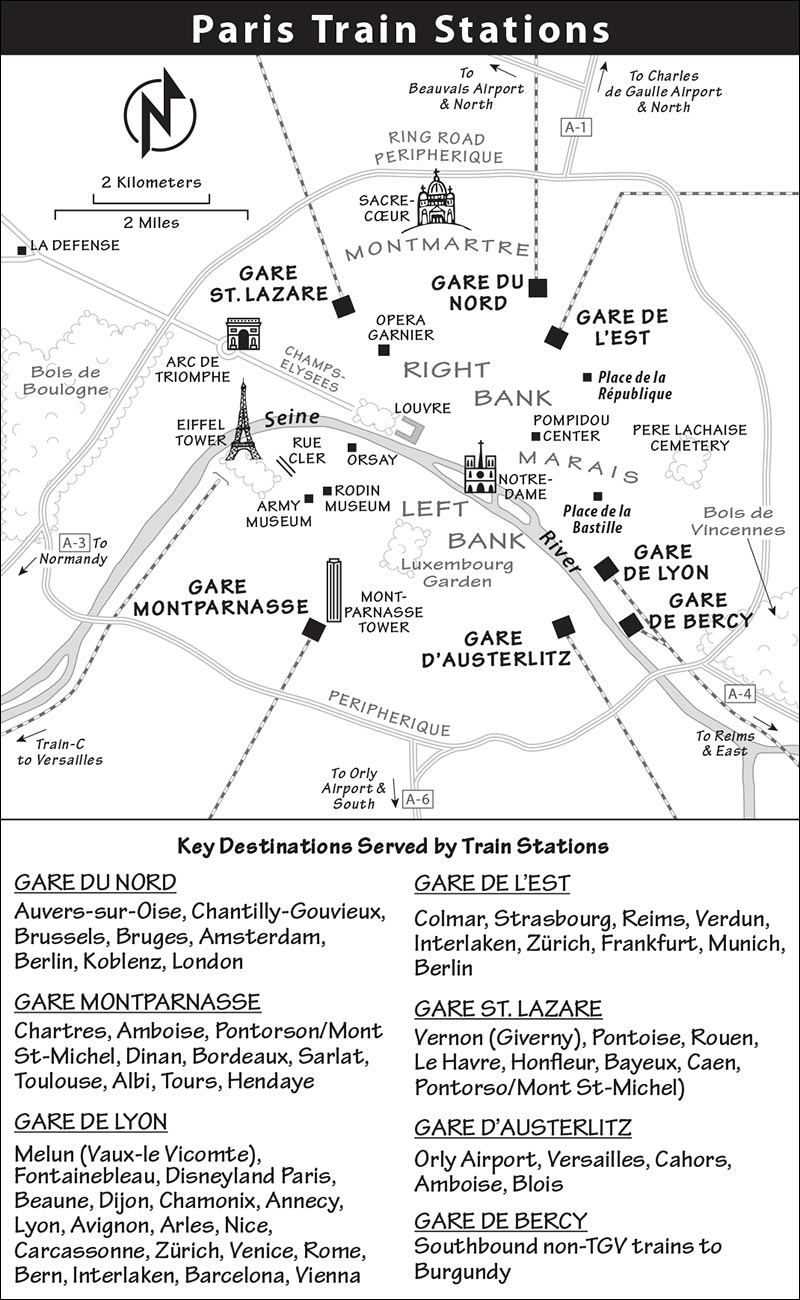
The granddaddy of Paris’ train stations serves cities in northern France and international destinations north of Paris, including Copenhagen, Amsterdam, and the Eurostar to London (see details later in this chapter), as well as two of the day trips described in this book (Chantilly and Auvers-sur-Oise).
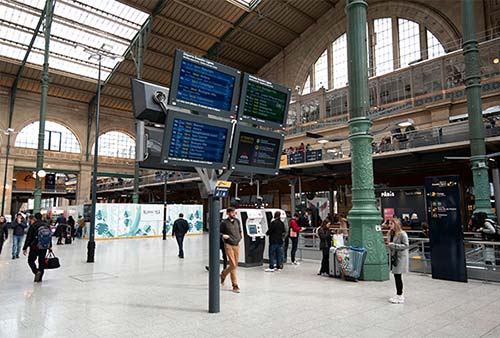
From the Métro, follow Gare du Nord signs through a maze of escalators and mezzanines to reach the tracks at street level. Grandes Lignes (main line) trains depart from tracks 2-21 (tracks 20 and 21 are around the corner), Suburban/Transilien lines (H and K) leave from tracks 30-36 (signed Ile-de-France), and RER trains (B, D, E) are signed one floor below. Eurostar trains (to London via the Chunnel) check in on the second level, up the stairs near track 17. The lounge for high-speed trains heading to Brussels and Amsterdam is at 22 Rue de Dunkerque (outside to the left if facing the train station).
Services: Look for circulating information-helpers. A helpful TI kiosk is opposite track 8. International and main-line ticket counters are opposite track 3. Tickets for other trains are sold at the windows past track 19 around the corner. Pay WCs are down the stairs across from track 10. Baggage check and rental cars are near track 3 and down the steps. Taxis are out the door past track 3. Steps down to the Métro are opposite tracks 10 and 19.
Key Destinations Served by Gare du Nord Grandes Lignes: Auvers-sur-Oise (hourly, 1.5 hours with transfer, one direct train April-Oct Sat-Sun only at about 9:30, 45 minutes, may not appear on rail websites except www.transilien.com, usually leaves from track 36), Chantilly-Gouvieux (look for destination “Creil” or “Compiègne,” every 1-1.5 hours, fewer on weekends, 25 minutes, also served by slower RER/Train-D), Brussels (at least hourly, 1.5 hours), Bruges (at least hourly, 3 hours, change in Brussels), Amsterdam (8/day direct, more with transfer, 3.5 hours), Berlin (6/day, 8.5 hours, change in Cologne or Dortmund), Koblenz (10/day, 5 hours, change in Cologne, more from Gare de l’Est that don’t cross Belgium), and London by Eurostar (1-2/hour, 2.5 hours).
By Banlieue/RER Lines: Chantilly-Gouvieux (3/hour, 50 minutes), Charles de Gaulle Airport (4/hour, 35 minutes, track 41-44), and Pontoise (2/hour, 50 minutes).
This big, modern station covers three floors, serves lower Normandy and Brittany, and has TGV service to the Loire Valley and southwestern France, as well as suburban service to Chartres. Trains to Chartres usually depart from tracks 18-24.
Services: Most services are provided on the top level (second floor up, Hall 1), where all trains arrive and depart. Baggage check (consignes) and WCs are by track 24, and the ticket office (billetterie) is by track 1. Taxis are to the far right. Car-rental desks are also to the right, along track 24, and up the escalator to Hall 2 (except Hertz, which has offices outside the station at 45 Avenue du Maine).
City buses are out front, between the train station and the Montparnasse Tower (down the escalator through the glassy facade). Bus #96 is good for connecting to Marais and Luxembourg-area hotels, while #92 is ideal for Rue Cler hotels (both easier than the Métro).
Key Destinations Served by Gare Montparnasse: Chartres (14/day, 1 hour), Amboise (10/day, 1.5-3 hours with change in St-Pierre-des-Corps, requires TGV reservation; non-TGV trains leave from Gare d’Austerlitz), Pontorson/Mont St-Michel (2-3/day, 4 hours, via Rennes or Caen), Dinan (6/day, 3 hours, change in Rennes and Dol), Bordeaux (hourly, 2.5 hours), Sarlat (4/day, 5 hours, change in Bordeaux), Toulouse (hourly, 4.5 hours, many with change in Bordeaux), Albi (almost hourly, 6.5 hours, change in Montauban or Toulouse), Tours (8/day, 1 hour), and Hendaye (8/day, 5 hours, connect here to San Sebastian by local train).
This huge, bewildering station offers TGV and regular service to southeastern France, Italy, Switzerland, and other international destinations. Frequent Banlieue trains serve Fontainebleau.
From the RER train or Métro, follow signs for Grandes Lignes/Gare de Lyon to reach the street-level platforms (Grandes Lignes and Banlieue lines share the same tracks). Platforms are divided into two areas: Hall 1 (tracks A-N) and Hall 2 (tracks 5-23). Hall 3 is underground with more ticket offices, food services, and quieter waiting areas—but no trains.
Monitors indicate the hall number at least 30 minutes before the track number is posted, so you know in advance from which hall your train leaves. For Grandes Lignes, arrive at your track at least 20 minutes early to pass ticket control (your ticket or reservation will be scanned).
Taxi stands are well signed in front of, and underneath, the station.
Services: An interior corridor connecting Halls 1 and 2 (by track A) offers many services, including shops and ticket windows for Grandes Lignes. Hall 2 has the best services—including a train-information office, a pharmacy, and a handy Monop grocery store. You’ll find baggage check (consignes) in Hall 2 down the ramp, opposite track 17, and in Hall 1, downstairs by track M. Car rental is out the exit past track M (Hall 1). There’s a Starbucks below Hall 2 with good Wi-Fi. Don’t leave the station without at least taking a peek at the recommended Le Train Bleu Restaurant in Hall 1, up the stairs opposite tracks G-L (no elevator, see listing on here). Its pricey but atmospheric bar/lounge works well as a quiet waiting area—and there’s Wi-Fi. Slip into a leather chair and time travel back to another era.
Key Destinations Served by Gare de Lyon: Vaux-le-Vicomte via Melun and Fontainebleau (nearly hourly, 30-45 minutes; depart from the Grandes Lignes level), Disneyland (RER/Train-A to Marne-la-Vallée-Chessy, at least 3/hour, 45 minutes), Beaune (roughly hourly at rush hour but few midday, 2.5 hours, most require change in Dijon; direct trains from Paris’ Bercy station take an hour longer), Dijon (TGV trains only, roughly hourly, 1.5 hours; see Gare de Bercy for local trains), Chamonix (6/day, 7 hours, two changes, some change in Switzerland), Annecy (hourly, 4 hours, many with change in Lyon), Lyon (at least hourly, 2 hours), Avignon (10/day direct, 2.5 hours to Avignon TGV station; 8/day, 3.5 hours to Avignon Centre-Ville Station), Arles (11/day, 4 hours), Nice (hourly, 6 hours, may require change; night train available, 12 hours), Carcassonne (10/day, 5-6 hours, 1-2 changes), Zürich (4/day direct, 4 hours; more with transfer, 6 hours), Venice (7/day, 11 hours with 1-3 changes), Rome (7/day, 12 hours, 1-3 changes), Bern (8/day with change in Basel, 4.5 hours), Interlaken (8/day with change in Basel, 6 hours, 8/day more from Gare de l’Est), Barcelona (2-4/day direct, 7 hours), and Vienna (3/week, 14 hours).
This two-floor station (with underground Métro and mini shopping mall) serves northeastern France and international destinations east of Paris. All trains depart at street level from tracks 1-30. Separate monitors show Ile-de-France and Grandes Lignes departures.
Services: A train-information and ticket office is opposite track 7 and around the corner. Most other services are on the floor below, opposite tracks 12-20 (baggage check, car rental, WC, small grocery store, and Métro access). Access to taxis and buses is in front of the station (exit with your back to the tracks).
Key Destinations Served by Gare de l’Est: Colmar (12/day by TGV, 2.5 hours, 3 direct, others change in Strasbourg), Strasbourg (hourly by TGV, under 2 hours), Reims Centre station (6/day by direct TGV, 45 minutes, more with transfer in Champagne-Ardenne, 75 minutes), Verdun (5/day direct to Meuse TGV station and shuttle bus, 2 hours; 3 hours with transfer), Interlaken (12/day, 6 hours, 1-2 changes, faster trains from Gare de Lyon), Zürich (12/day, 5-7 hours, 1-2 changes, faster direct trains from Gare de Lyon), Frankfurt (4 direct/day, 4 hours; more with change in Karlsruhe, 4.5 hours), Munich (1/day direct, 6/day with 1 change, 6 hours), and Berlin (6/day, 8.5 hours, 1 change; trains run via Germany, not Belgium).
This compact station serves upper Normandy, including Rouen and Giverny. All trains arrive and depart one floor above street level.
From the Métro, follow signs to Grandes Lignes to reach the tracks a few floors up (escalators available). You’ll pass through several levels of shops, including a good grocery shop and pharmacy. On departure monitors, purple squares are for tracks 1-11, green for tracks 12-21, and blue for tracks 22-27. Most Grandes Lignes to Normandy depart from tracks 22-27 (though a few depart from the Ile-de-France section). Ile-de-France trains depart from 1-16. The ticket and information office, car rental, and WCs are near track 27. The Ile-de-France train information office is opposite track 6. Baggage check is available near the station at Annexx Lockers (6 Rue de Constantinople, www.lockers.fr). Taxis, the Métro, and buses are well signed.
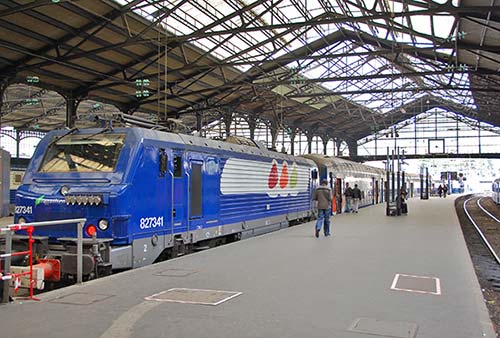
Key Destinations Served by Gare St. Lazare: Giverny (train to Vernon, about hourly, 1 hour; then bus to Giverny, 2/hour, 15 minutes), Pontoise (1-2/hour, 40 minutes), Rouen (nearly hourly, 1.5 hours), Le Havre (hourly, 2.5 hours, some change in Rouen), Honfleur (13/day, 2-3.5 hours, via Lisieux, Deauville, or Le Havre, then bus), Bayeux (hourly, 2.5 hours, several direct, most change in Caen), Caen (hourly, 2.5 hours), and Pontorson/Mont St-Michel (4/day, 4-5.5 hours, via Caen; more trains from Gare Montparnasse).
This small station currently provides non-TGV service to the Loire Valley and southwestern France (several tracks are being retrofitted to accommodate TGV trains). All tracks are at street level. A comfortable waiting room is opposite track 17, and all ticket sales are in the riverside entry hall. Baggage check and WCs are at “Espaces Services,” near track 1.
To get to the Métro and RER/Train-C, you must walk outside and along either side of the station. Car rental is across the river at Gare de Lyon (a level 10-minute walk—follow signs opposite track 1).
Key Destinations Served by Gare d’Austerlitz: Orly Airport (via RER/Train-C, 4/hour, 35 minutes to the Pont de Rungis station, then take bus #183), Versailles (via RER/Train-C, 4/hour, 35 minutes), Amboise (10/day, 2 hours direct, 2.5 hours with transfer, usually in Orléans), and Blois (12/day, 1.5 hours direct, 2 hours with transfer, usually in Orléans).
This smaller station mostly handles southbound non-TGV trains such as to Dijon (6/day, 3 hours), but some TGV trains also stop here in peak season (Mo: Bercy, one stop east of Gare de Lyon on line 14, exit the Bercy Métro station and it’s across the street). Facilities are limited—just a WC and a sandwich-fare takeout café.
A TGV train called OuiGo (pronounced “we go”) Grande Vitesse offers rock-bottom fares and no-frills service to select French cities also served by regular TGV trains. Departures are from TGV stations at Gare de Lyon, Gare Montparnasse, Gare de L’Est, Charles de Gaulle Airport, and Marne-la-Vallée (near Disneyland). Tickets are sold online only, rail passes are not accepted, and you can bring only one carry-on-size bag plus one handbag for free (children’s tickets allow you to bring a stroller). There’s no food service on the train (BYO), but children under age 12 pay only €8 for a seat. The website explains it all (www.sncf-connect.com/en-en/ouigo).
The Eurostar zips you from downtown Paris to downtown London at 190 mph in 2.5 hours (about hourly). The tunnel crossing is a 20-minute, silent, 100 mph nonevent. Your ears won’t even pop.
Eurostar Tickets and Fares: A one-way ticket between London and Paris can vary widely in price; for instance, $60-275 (Standard class), $150-375 (Standard Premier), and $400 (Business Premier). Fares depend on how far ahead you reserve and whether you’re eligible for discounts—available for children (under 12), youths (under 26), and adults booking months ahead or traveling round-trip. You can book tickets up to four to six months in advance. Tickets can be exchanged before the scheduled departure for a fee (about $55, may be waived for early exchanges), plus the cost of any price increase, but only Business Premier class allows a refund.
Buy tickets ahead at RickSteves.com/Rail or at Eurostar.com (French toll +33 1 70 70 60 88, €14 handling fee if you book by phone). In continental Europe, you can buy Eurostar tickets at any major train station in any country or at any travel agency that handles train tickets (booking fee).
If you have a Eurail Global Pass, seat reservations are available at Eurostar departure stations, Eurail.com, or by phone with Eurostar (generally harder to get at other train stations and travel agencies; $35 in Standard, $45 in Standard Premier, can sell out).
Taking the Eurostar: Eurostar trains operate from Paris’ Gare du Nord. Arrive early to go through security and passport control (must be completed at least 30 minutes before departure). Times listed on tickets are local; Britain is one hour earlier than continental Europe. The currency-exchange booth here has rates about the same as you’ll find on the other end. There’s a reasonable restaurant before the first check-in point but only a couple of tiny sandwich-and-coffee counters in the cramped waiting area.
Crossing the Channel Without Eurostar: For speed and affordability, look into cheap flights. The old-fashioned ways of crossing the Channel are cheaper than Eurostar (taking the bus is cheapest; see the Practicalities chapter)—but twice as complicated and slow. To go by train and boat to London, take the TGV train from Paris to Calais, taxi to the port, then catch a P&O ferry to Dover, England (hourly, 1.5 hours, www.poferries.com). From Dover’s Priory Station, take a train to London’s St. Pancras, Charing Cross, or Victoria Station (hourly, 1-2 hours).
Without a rail pass, for the Paris-Amsterdam train, you’ll pay about €80-205 first class, €35-135 second class (compared to €38-50 by bus); for the Paris-Brussels train, it’s €65-140 first class, €30-100 second class (€20-30 by bus). Even with a rail pass, you need to pay for train reservations (first class-€25-30, includes a light meal; second class-€20-25). Book early for the best rates (discounted seats are limited, www.eurostar.com).
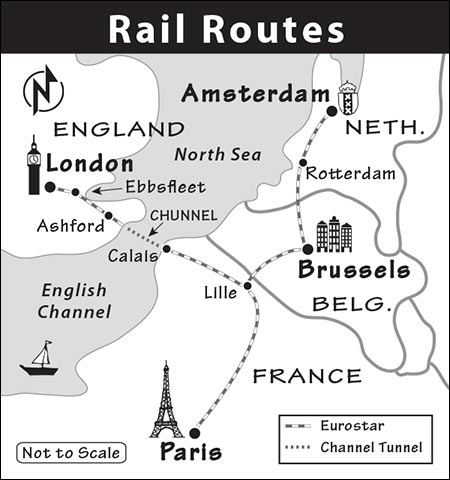
Buses run by FlixBus or BlaBlaCar generally provide the cheapest—if more time-consuming—transportation between French cities, airports, and popular destinations without convenient rail connections (such as Mont St. Michel). See the Practicalities chapter for details.
Prepare for monumental traffic jams during rush hour and slow driving at any time in Paris. Speeds are limited to 30 kph (about 19 mph) on all Paris streets within the périphérique (ring road) freeway. Remember that bus lanes (there are many) are off-limits to cars.
Street parking is generally free at night (20:00-9:00) and all day Sunday. To pay for streetside parking, use a credit card. Meters limit street parking to a maximum of two hours; a full day on the street will cost you about €65.
Underground garages are also plentiful in Paris; for locations, see www.parisfranceparking.com. Some hotels offer discounted parking—ask your hotelier.
For a longer stay, park at an airport (about €20/day) and take public transport or a taxi into the city. Orly is closer and easier for drivers to navigate than Charles de Gaulle.
BlaBlaCar is a popular long-distance ride-sharing service connecting drivers with riders, enabling travelers to share the cost of gas, tolls, and other expenses (www.blablacar.in). It’s the cheapest way to get around France.
Though it’s a landlocked city, Paris is a popular cruise destination. Ships visiting “Paris” actually call at the industrial city of Le Havre, France’s second-biggest port (after Marseille), and the primary French port on the Atlantic.
Paris and Le Havre are connected by train (about 3 hours each way). To get from the port to the Le Havre train/bus station, you can ride a cruise-line shuttle bus or take a taxi. From there, trains leave about every one to two hours for the three-hour journey to Paris’ St. Lazare station (fewer on weekends).
For port information, see LeHavre-Etretat-Tourisme.com.